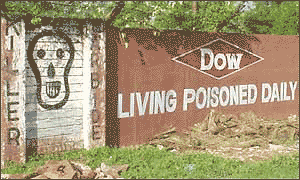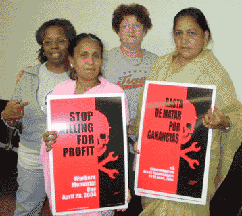

In December 1984 over 40 tons of toxic chemicals leaked from a pesticide factory located in a poor neighborhood in Bhopal, India exposing half a million people, 80% of whom were working class. An estimated 8,000 people died within hours. 150,000 more suffer from exposure related illnesses. The death toll from the incident continues to rise. About 400 people a year currently die from the effects of the incident, with a total death toll of about 27,000. Among the survivors nearly 50,000 are too sick to work.
Union Carbide blamed the disaster on a disgruntled (and as yet unnamed) worker and abandoned the plant following the disaster without cleaning up the area and made a closed-doors "settlement" with the Indian government that gave survivors a paltry $500-$1200 each, no where near the actual costs of health care. Many victims still haven't received this money and this month a local court directed the government to distribute the remaining $280 million.
In 2001 Dow Chemical of Midland, Michigan bought Union Carbide. Dow's website reveals the company is hiding behind a tortured mess of legal illogic that concludes with no one being responsible. There is an excellent satiric take-off on Dow site here.
Bhopal survivors, however, have never given up their struggle for justice.
Although industrial disasters are commonly referred to as "accidents" they are not really "accidental". To say the incident at Bhopal was an "accident" implies it was something that "just happened", that it was "fate", and maybe couldn't have been prevented. That isn't true. Such events happen because of decisions made by people.
Among the choices made by top management in the US regarding the pesticide plant in Bhopal were these: the equipment was under maintained, faulty, improper, and in a state of disrepair. Trained safety personnel were cut from twelve to six. Safety systems were not designed to handle the kind of runaway reaction that occurred. Management saved on electricity bills by shutting off refrigeration equipment intended to keep the methyl isocyanate close to zero degrees centigrade.
The large amount chemicals stored on site was not an accident. Nowhere else in the world was this much methyl iscocyanate stored in one place.
Building the plant in a heavily populated area and turning off the emergency warning siren were not "accidents", they were choices made by management.
A year before the tragedy the potential hazard was discussed in the Madhya Pradesh legislature. The Labor Minister confidently stated, "There is no danger in Bhopal, nor will there ever be," despite several workers having been poisoned already. Workers and Carbide safety auditors warned the company of the potential for serious disaster.
On the night of December 3, 1984 one supervisor was left to attend to the controls. Water that was being used to clean pipes entered a tank containing methyl isocyanate (MIC) through leaking valves. When the water entered the tank of non-cooled MIC it set off a runaway reaction causing the release of a lethal gas mixture spewing a toxic cloud over an area of 8 square miles. The first autopsies showed human blood that had thickened and turned purple red, lungs turned ash color and filled with their own secretions, and tracheas so dry that mucous flaked off on being touched.
J. Mukund, the plant manager confidently said, "The gas leak just can't be from my plant. The plant is shut down. Our technology just can't go wrong, we just can't have such leaks." When the source of the leak was confirmed the Union Carbide chief medical officer denied that methyl isocyanate could be fatal. He said it is just a minor irritant.
Immediate effects included the death of 8,000 people, countless animals, and the destruction of the local environment.
Continuing symptoms among the 500,000 exposed individuals include respiratory problems, neurological disorders, recurrent fever, anxiety and depression. Research shows chromosome damage suggesting that future generations will inherit problems.
Even nineteen years later the holistic Sambhavna ("possibility" in Hindi) Clinic sees 110 people a day suffering from internal organ damage, vision problems, shortness of breath, persistent coughs, menstrual irregularities, fatigue, depression, anxiety and a host of other painful disorders. "Right from the beginning, it was very obvious that modern medicine wasn't working for all the health problems", says Sathyu Sarangi, an engineer turned activist who helped found the clinic. The clinic was began because people believed that government officials, out of fear of "jeopardizing the investment climate", were not paying attention to continuing effects of the gas leak such as tuberculosis, cancer, reproductive problems showing up in survivors.

Union Carbide CEO Warren Anderson and other company officials were arrested soon after but were released on bail and allowed to leave the country. Three years later a Bhopal District Court charged Union Carbide and its officials, with culpable homicide and other serious offences. After five years a warrant was issued for Anderson's arrest. Last year another Indian court upheld the charge of 'culpable homicide not amounting to murder'. In June 2003 the Indian government was finally forced by survivors to petition the US government for extradition of Warren Anderson. No response from the US government has been reported.
Referring to the extradition warrant Rashida Bee, president of the Bhopal Gas Peedit Mahila Stationery Karmachari Sangh (Bhopal Gas-Affected Women Stationery Workers Association) said, "This long-awaited move is a major step towards in our struggle for justice. We will continue to pressure the government till Anderson and others responsible for the world's worst disaster face trial in the ongoing criminal case."
"Criminal trial of corporate CEOs is not merely a necessary legal measure for justice in Bhopal. It is an essential prerequisite for tackling the growing crisis of corporate crime," says Raj Sharma, an attorney representing the survivors in a class action suit.